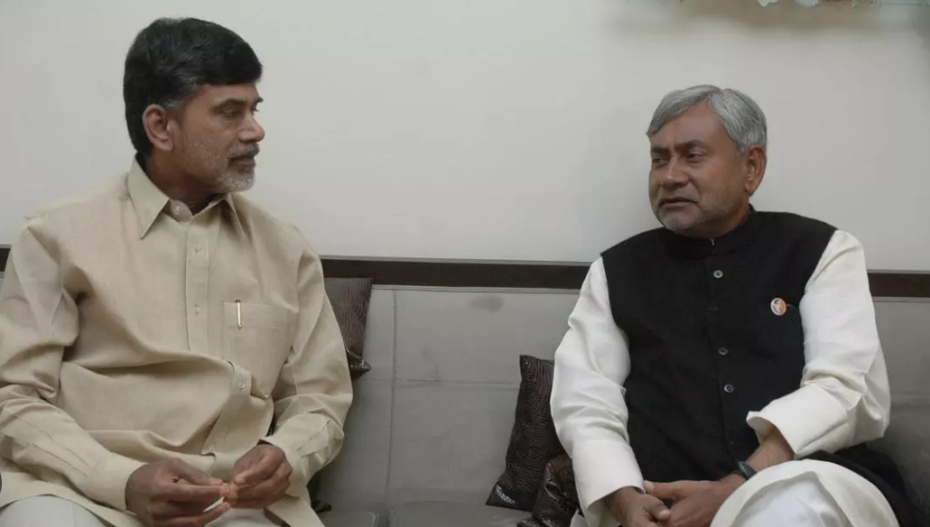Andhra’s Chandrababu Naidu of the Telugu Desam Party (TDP) and Bihar’s Nitish Kumar of the Janata Dal (United) have emerged as the kingmakers in the new BJP-led NDA government at the Centre following the saffron party’s failure to reach the majority mark on its own. The two parties are constituents of the NDA 2 alliance.
Naidu contested the Lok Sabha polls and the Assembly elections in Andhra Pradesh in alliance with the BJP and the JanaSena Party (JSP). Leading or having won 134 of Andhra’s 175 Assembly seats, Naidu does not need the BJP’s support to form the state government but will play a decisive role in forming the next Union government. Naidu’s son Nara Lokesh Naidu who is poised to enter the Assembly for the first time — he won from Mangalagiri — said the TDP would stay with the NDA. He said on all other issues they would try to arrive at a consensus with the BJP.
Meanwhile, having made massive gains, the INDIA alliance has also reportedly sent feelers to Naidu. The Congress is sending signals to Naidu about granting Andhra Pradesh Special Category Status (SCS) so that it can receive additional funds and give subsidies to bring in investments. Congress leader Jairam Ramesh even tweeted the Congress’s manifesto in which it promised SCS for Andhra Pradesh.
Sources in the TDP said there was a strong negative sentiment among the people of Andhra Pradesh towards the Congress, which they blame for the state’s bifurcation in 2014. “Even the 10-year gap has not pacified the people as the Congress is not winning a single Assembly or Lok Sabha seat in Andhra Pradesh. It did not win in 2014 or 2019 either. To align with the INDI Alliance means Naidu risks the wrath of the people. JSP chief K Pawan Kalyan who offered unflinching support to Naidu and TDP will also not agree,” said a TDP leader.
This is not the first time that Naidu has found himself in this position. In 1996, when the electorate delivered a fractured mandate in the Lok Sabha polls, Naidu, as the convenor of the United Front, a coalition of parties not aligned with either the Congress or the BJP, propped up the HD Deve Gowda government with outside support from the Congress. He also helped form a government at the Centre with IK Gujaral at the helm during this period.
In 1999, Naidu contested the Lok Sabha polls in alliance with the BJP and notched up 29 seats in united Andhra Pradesh. He supported the then Atal Bihari Vajpayee government that was short of the majority mark. In fact, with 29 seats, the TDP was BJP’s biggest ally although it did not join the government.
In 2014 too, Naidu contested in alliance with the BJP and joined the Modi government, only to leave the alliance in 2018 ahead of Assembly polls in Andhra Pradesh over the BJP-led Centre’s alleged failure to fulfil any promises made in the AP Reorganisation Act, 2014, including not granting SCS to the state. Sources said Naidu anticipated that the BJP would be defeated in the 2019 elections. But, the TDP was routed by the YSRCP and since then Naidu started trying to get back into the NDA to keep his party afloat.
The TDP, though formed on a plank of anti-Congressism, has earlier done business with the grand old party. It not only contested the Telangana Assembly polls in alliance with the Congress but even tried to stitch an Opposition alliance with the Congress in the lead ahead of the 2019 polls.
Meanwhile, a veteran of social justice politics in Bihar, Nitish Kumar was briefly the Union Minister for Railways and Minister for Surface Transport and, later, the Minister for Agriculture in 1998-’99 in the NDA government of Vajpayee. He again got the portfolio in the Vajpayee government from 2000 to 2004.
For the longest time, Nitish remained the senior partner in the NDA in Bihar and was the BJP’s biggest ally in 2009, winning 20 seats in the state when the saffron party did poorly at the national level.
However, of late Nitish’s politics has been characterised by a series of flip-flops. In 2014, he broke away from the NDA protesting the rise of Narendra Modi and contested the Bihar Lok Sabha polls alone but won only two seats. Following this, he joined hands with Lalu Yadav for the 2015 Assembly elections and the alliance swept the polls.
Within two years, however, he broke away and joined the NDA again and the alliance swept Bihar Lok Sabha polls winning 39 of the 40 seats. However, after the JDU fared poorly in the 2020 Bihar Assembly polls despite the alliance winning the elections, Kumar became increasingly uncomfortable with the BJP and broke the alliance in 2022 to form a government with the RJD. However, this January, Kumar again returned to the NDA. The JD(U)’s better showing than its alliance partner in Bihar in these polls has once again brought Kumar to the centre stage and given a new lease of life to his party.
Also Read: 3-time BJP MP Lalu Patel defeated by Independent in Daman & Diu












